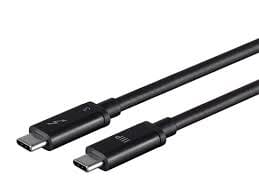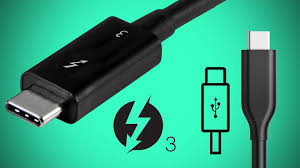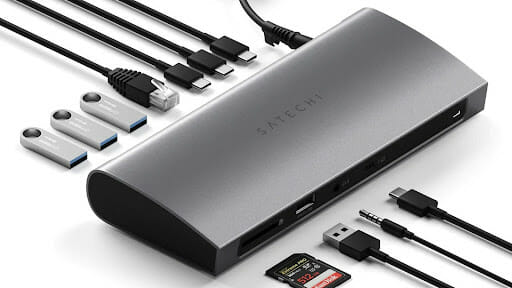Thunderbolt and USB C are two high-speed connectivity options that have taken the tech world by storm, but what’s the difference between them? In this write-up, we’ll explain everything you need to know about them.
So, is Thunderbolt the same as USB C?
Thunderbolt is definitely NOT the same as USB C, although it can use the same connector type as USB C. A powerful tool for high-speed transfer of data, Thunderbolt is best used with a certified adaptor and cable for best performance. This will also prevent any compatibility problems.
Key Takeaways
- Thunderbolt and USB-C are two different technologies that need to be distinguished from each other
- Thunderbolt technology is a powerful tool for high-speed data transfer, video output, and power delivery
- Thunderbolt devices may require specific cables and adapters for optimal performance, and it’s essential to use certified Thunderbolt cables and adapters to avoid compatibility issues
- Upgrading from Thunderbolt 2 or older to Thunderbolt 3 or Thunderbolt 4 can provide significant performance improvements
Table Of Contents
Thunderbolt and USB-C Technology
Thunderbolt and USB-C are two technologies that allow for high-speed data transfer. The speed of a Thunderbolt connection depends on the version of Thunderbolt being used and the devices connected to it. However, both are significantly faster than older technologies like USB 2.0. In addition, both technologies use the same connector type to use a Thunderbolt cable with a USB-C port or vice versa.
Importance of Distinguishing Between Thunderbolt and USB-C
The most popular types of connections currently available are Thunderbolt and USB-C. Although you can use these connection types for various purposes, knowing the difference between them is essential to ensure you use the correct type of connection for your needs.
Related: USB-C Memory Sticks – Everything You Need To Know
Thunderbolt to USB
A Thunderbolt-to-USB adapter is a device that allows you to connect a Thunderbolt-compatible device to a computer or other device that uses a USB port. This can be useful if you want to join a Thunderbolt-compatible device to a computer that does not have a Thunderbolt port or to connect multiple Thunderbolt-compatible devices to a single computer.

Image by Shopfsi
Advantages of Using Thunderbolt to USB Adapter
- A Thunderbolt to USB adapter allows you to connect to a computer that does not have a Thunderbolt port.
- The device provides faster data transfer speeds than a standard USB connection. This can be beneficial when transferring large files between devices.
Disadvantages of Using Thunderbolt to USB Adapter
- Using Thunderbolt to USB adapter can decrease the speed of data transfer.
Compatibility Issues With Older Devices
Thunderbolt is a newer technology than USB; thus, not all older devices are compatible. You can resolve this by using an adapter that converts Thunderbolt to USB. You can also use a device specifically designed for Thunderbolt compatibility, such as the Apple Thunderbolt Display.
Thunderbolt 2 to USB-C
Thunderbolt 2 is a high-speed interface that can transfer data at up to 20Gbps. It is also capable of powering devices and charging laptops. USB-C is a new type of reversible connector to plug in either direction. It has a maximum data transfer rate of 10Gbps, which you can use for charging devices.
Compatibility Issues Between Thunderbolt 2 and USB-C
Thunderbolt 2 uses a different connector than USB-C, so not all devices with a Thunderbolt 2 port will be compatible with USB-C devices.
In addition, Thunderbolt 2 has a maximum bandwidth of 20 Gbps, while USB-C can reach speeds of 10 Gbps. If you’re using a Thunderbolt 2 device with a USB-C device, you will not be able to enjoy the full-speed capabilities.
Advantages of Upgrading to Thunderbolt 3 or Thunderbolt 4
Thunderbolt 3 and 4 support much higher data transfer speeds of up to 40Gbps for Thunderbolt 3 and 48Gbps for Thunderbolt 4.
They also support longer cable lengths, up to 100m with active cables, and allow for simultaneous charging and data transfer.
Thunderbolt 3
Thunderbolt 3 is the second newest, fastest, and most versatile connection standard available. You can use it on your PCs and Macs, enabling data transfer speeds of up to 40 Gbps. That’s double the speed of Thunderbolt 2 and 8X faster than USB 3.0. Thunderbolt 3 also supports dual 4K displays or a single 5K display.
Advantages of Thunderbolt 3
- High Speed: Thunderbolt 3 provides a maximum 40 Gbps data transfer speed, four times quicker than USB 3.1 Gen 2. It’s also faster than Thunderbolt 2.
- Versatility: The device has a versatile interface that supports many peripherals, such as docking stations, external hard drives, and displays for multiple connections.
- Display Support: Thunderbolt 3 supports display for devices with up to 5k resolutions, thus helping improve high-quality visuals.
Disadvantage
- Limited Availability: The technology is new and therefore incompatible with all computers.
Examples of Devices That Use Thunderbolt 3 Technology
Displays that support Thunderbolt 3 include:
- Apple Studio Display
- Apple Pro Display XDR
- LG UltraFine 5K Display
- USB-C cables operate when you connect them to Mac without an adapter
Thunderbolt 3 to USB-C

Image by M3.idg
If your computer or other devices have a USB-C port, you can utilize Thunderbolt 3. However, not all devices, host connections, or USB-C connectors connect with Thunderbolt 3. This means your device’s USB-C can be compatible with a Thunderbolt 3 host connection, but a Thunderbolt 3 device cannot be compatible with your device’s USB-C host connection.
Advantages of Using Thunderbolt 3 to USB-C Adapter
- Thunderbolt 3 to USB-C adapter connects a Thunderbolt 3 device to a USB-C port. This is useful if you have a Thunderbolt 3 device that you want to use with a laptop that only has a USB-C port.
- The adapter can provide up to 40 Gbps of data transfer speed. This is faster than the maximum data transfer speed of USB 3.1(10 Gbps).
Disadvantage
The adapter only supports a single Thunderbolt 3 device. Therefore, if you have multiple devices, you’ll need to purchase multiple adapters.
Related: Mini USB vs Micro USB: What Are The Differences?
Thunderbolt 4 Power Delivery
Thunderbolt 4 is the latest version of Intel’s Thunderbolt technology. It offers several improvements over previous versions, including increased power delivery. It can provide up to 100 watts of power, making it ideal for charging laptops and other high-power devices. It also supports data transfer speeds of up to 40 gigabits per second.
Advantages of Thunderbolt 4 Power Delivery
- Flexibility: Thunderbolt 4 has ports that can power your devices, other ports can transfer data from your devices to your PC, and video signals from your PC to a separate external monitor.
- Bandwidth: Thunderbolt 4 ports can transfer 40 Gbps. Therefore, you can transfer data faster to external storage on up to five Thunderbolt devices.
- Versatile Connectivity: Thunderbolt 4 ports are compatible with many devices and standard connections.
Compatibility Issues with Older Devices
Thunderbolt 4 Power Delivery Compatibility Issues with older devices can be a real pain. If you have an older device that isn’t compatible with the new standard, you’ll need to find an adapter or cable that will work with both standards.
Thunderbolt 4 Dock
A Thunderbolt 4 dock lets you connect multiple peripherals and devices to your computer using a single Thunderbolt 4 cable. This can be convenient when connecting various devices. Thunderbolt 4 docks also offer higher bandwidth than others, so they are ideal for creative professionals.
Advantages of Thunderbolt 4 Dock
- It enables multiple devices to connect to a single computer with ease, including charging capabilities.
- With support for up to 40Gb/s data transfer speeds, these docks make it easy to offload files from external drives or connect high-resolution displays quickly.
Disadvantages of Thunderbolt 4 Dock
- Thunderbolt 4 dock is not compatible with all devices.

Image by Macrumors
Compatibility Issues with Older Devices
One way to solve Thunderbolt 4 dock compatibility issues with older devices is to use a Thunderbolt 3 to Thunderbolt 4 adapter. This adapter will allow you to connect your older device to the dock using a Thunderbolt 3 cable. Another way is to use a different type of dock compatible with your older device.
Related: Best USB Hub for Gaming in 2023
Thunderbolt 4 Speed
Thunderbolt 4 is the next generation of Thunderbolt technology, offering incredible data transfer speeds of up to 40 Gbps. The new standard also provides full compatibility with USB4 to connect various devices to your Thunderbolt 4-enabled computer. It also offers a significant speed boost over previous generations, making it ideal for video editing and large file transfers.
Comparison of Thunderbolt 4 Speed With Other Technologies
Thunderbolt 4 is the fastest data transfer technology available today. It’s also versatile and can support various devices with different bandwidth needs. This is the comparison it has to other technologies:
USB 3.2 Gen 2×2 offers up to 20 Gbps, so Thunderbolt 4 is twice as fast.
Thunderbolt 3 offers up to 40 Gbps, so Thunderbolt 4 is no faster regarding raw speed. However, Thunderbolt 4 offers additional features that make it superior to Thunderbolt 3.
Advantages of Thunderbolt 4 Speed
- Thunderbolt 4 supports up to four lanes of PCIe data, supporting up to two 4K displays or one 8K display at 60Hz.
- Thunderbolt 4 offers enhanced security features.
- Thunderbolt 4 is much more power-efficient than previous versions.
Disadvantage
- Not all devices are compatible with Thunderbolt 4 and compatibility issues with older devices may require the use of adapters or a different type of doc.
Related: USB 3.1 Gen 1 vs Gen 2 – What’s The Difference?
Conclusion
Thunderbolt and USB C are both great data transfer technologies, but as you can see, they’re different. While USB C is a standard that all devices should use, Thunderbolt technology offers faster speeds and more connection options. So if you want to transfer large files quickly or connect multiple 4K displays to your laptop, Thunderbolt is the way to go. Ultimately, it comes down to your needs when deciding which is suitable for you.
Sources:


